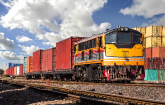NEW YORK, Feb. 23, 2023 /PRNewswire/ --
Major players in the intermodal market are Union Pacific Railroad, Canadian National Railway, CSX Transportation, Norfolk Southern Railway, BNSF Railway, DB Schenker, SBB Cargo, CTL Logistics, VTG Rail Logistics, and Kuehen+Nagel Logistics.
Read the full report: https://www.reportlinker.com/p06250372/?utm_source=PRN
The global intermodal market will grow from $23.37 billion in 2022 to $26.49 billion in 2023 at a compound annual growth rate (CAGR) of 13.4%. The Russia-Ukraine war disrupted the chances of global economic recovery from the COVID-19 pandemic, at least in the short term. The war between these two countries has led to economic sanctions on multiple countries, surge in commodity prices, and supply chain disruptions, causing inflation across goods and services effecting many markets across the globe. The intermodal market is expected to grow to $41.59 billion in 2027 at a CAGR of 11.9%.
The intermodal market includes revenues earned by entities by transporting freight using more than two modes of transportation to reduce cost, pollution, and traffic obstructions.The market value includes the value of related goods sold by the service provider or included within the service offering.
Only goods and services traded between entities or sold to end consumers are included.
Intermodal refers to a mode of transportation in which the handling of the freight is not done manually when changing a rail carrier, thus increasing the security of the transported product substantially. It provides the transportation of freight in an intermodal container and offers a safe and secure system that stops handling too much freight while it's being transported.
North America was the largest region in the intermodal market in 2022.Asia Pacific was the second largest region in the intermodal market.
The regions covered in intermodal market report are Asia-Pacific, Western Europe, Eastern Europe, North America, South America, Middle East, and Africa.
The main types in the intermodal market are container-on-flatcar (COFC) and trailer-on-flatcar (TOFC).The COFC is a type of rail freight service in which an empty container is loaded and transported on the train's flatcar.
The market is covered by destination into domestic and international and by application into oil and gas, aerospace and defense, industrial and manufacturing, construction, chemical, food and beverages, healthcare, and others.
The sustainable nature of intermodal rail transport is expected to drive the intermodal market.Unlike truckloads, rails use less fuel and are faster, which makes intermodal transportation energy and cost-efficient.
Over the years, rail fuel efficiency has firmly increased, making it the most environmentally sustainable means of transporting goods overland.According to the Association of American Railroads (AAR), the USA's freight railways can move one tonne of freight more than 470 miles per gallon of fuel on an average.
AAR's analysis of federal data finds that if 25% of truck traffic travelling at least 750 miles went by rail instead, annual greenhouse gas emissions were expected to fall by around 13.1 million tonnes, and if 50% of truck traffic moving at least 750 miles, greenhouse gas emissions dropped by about 26.2 million tonnes. The most fuel-efficient form of land transport is moving freight by rail, which reduces transportation costs and promotes brand control for a sustainable environment that encourages the growth of the intermodal market.
The competition from the trucking market is anticipated to hinder the intermodal market over the forthcoming years.Limited origin and destination pairing and finite market providers are the major limitations of intermodal over truck loads.
Intermodal is not the appropriate solution for every possible origin and destination zip code pairing due to the restricted number of intermodal railroad ramps and dray typically needs to be within 100 miles of their respective ramp.Moreover, the limited number of rail intermodal providers over truckloads is another major challenge for the rail intermodal industry.
Thus, truckloads are preferred over rail transport, subsequently restricting the growth of the intermodal market.
Organizations are implementing precision-scheduled railroading that has been gaining popularity in the intermodal market over the past few years.Precision scheduled railroading (PSR) is a plan that includes centralizing operations, reducing staff, running fewer, heavier, faster trains, and optimizing the network to increase efficiency.
For instance, in July 2021, the US Government Accountability Office, a US-based investigation agency, launched precision railroading to improve rail safety and tracking, and to improve cost structure, customer service, and consistent and reliable operations.
In June 2020, the Canadian Pacific Railway (CP), a Canadian-based railway offering transportation services and supply chain expertise across North America, acquired the entire network of the Central Maine and Quebec Railway (CMQ) for an undisclosed amount.The acquisition provides CP with direct links to Searsport, Maine, and Port Saint John, New Brunswick's Atlantic seaports, which offer CP a 320 km shorter route than competing railways from the east coast to Montreal and Toronto.
It also enabled the company to serve customers through a larger coast-to-coast network across Canada and deliver direct Class 1 freight-rail service, including intermodal services, to the State of Maine. Central Maine and Quebec Railway is a Class II freight railway based in the United States that provides intermodal services.
The countries covered in the intermodal market are Australia, Brazil, China, France, Germany, India, Indonesia, Japan, Russia, South Korea, UK, and USA.
The market value is defined as the revenues that enterprises gain from goods and/or services sold within the specified market and geography through sales, grants, or donations in terms of currency (in USD ($) unless otherwise specified).
The revenues for a specified geography are consumption values – that is, they are revenues generated by organizations in the specified geography within the specified market, irrespective of where they are produced. It does not include revenues from resales either further along the supply chain or as part of other products.
The intermodal market research report is one of a series of new reports that provides intermodal market statistics, including intermodal industry global market size, regional shares, competitors with an intermodal market share, detailed intermodal market segments, market trends and opportunities, and any further data you may need to thrive in the intermodal industry. This intermodal market research report delivers a complete perspective of everything you need, with an in-depth analysis of the current and future scenario of the industry.
Read the full report: https://www.reportlinker.com/p06250372/?utm_source=PRN
About Reportlinker
ReportLinker is an award-winning market research solution. Reportlinker finds and organizes the latest industry data so you get all the market research you need - instantly, in one place.
Contact Clare: [email protected]
US: (339)-368-6001
Intl: +1 339-368-6001
SOURCE Reportlinker

WANT YOUR COMPANY'S NEWS FEATURED ON PRNEWSWIRE.COM?
Newsrooms &
Influencers
Digital Media
Outlets
Journalists
Opted In




Share this article